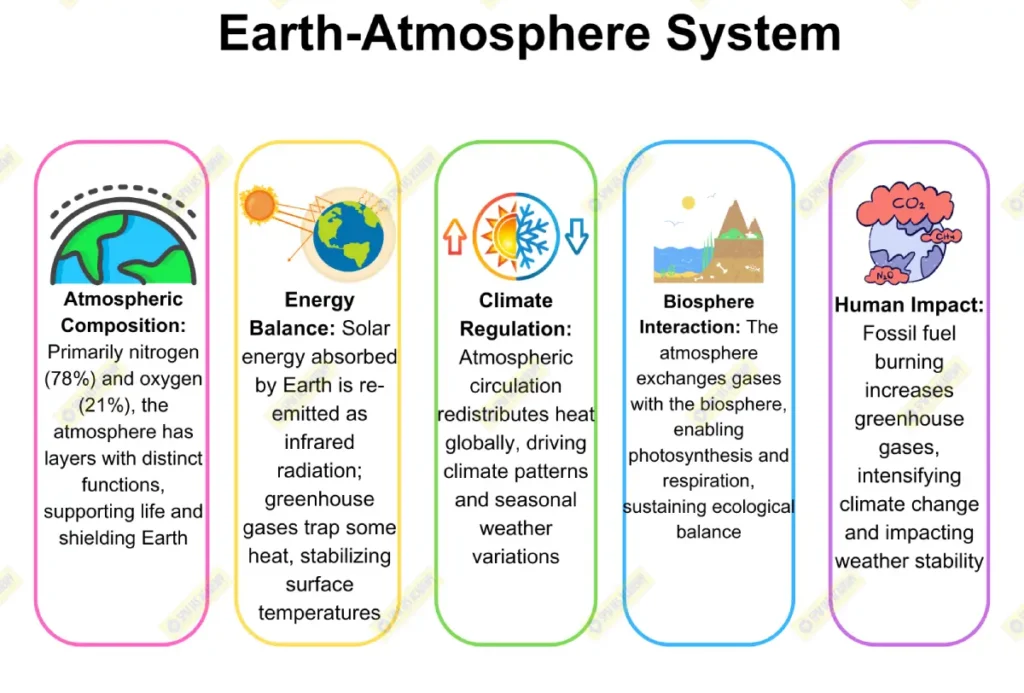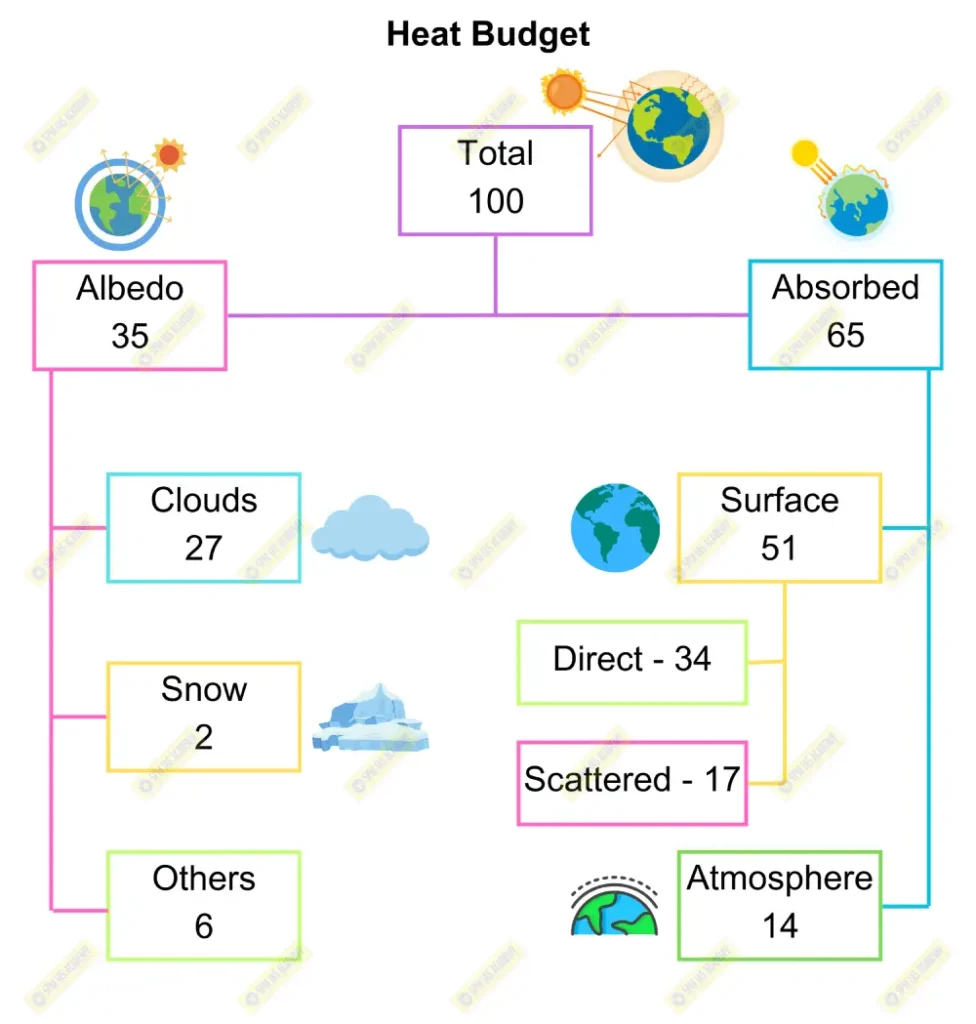The Earth-atmosphere system maintains heat balance through a series of dynamic processes that regulate the flow and distribution of solar energy received, absorbed, and emitted by Earth. This balance is crucial for maintaining temperatures conducive to life and ensuring climate stability. The global heat balance is achieved through processes of incoming solar radiation, terrestrial radiation, conduction, convection, latent heat transfer, and atmospheric circulation.

1. Incoming Solar Radiation (Insolation)
- The Sun emits energy that reaches Earth as shortwave radiation, primarily in the visible and ultraviolet spectrum. On average, Earth receives about 342 W/m² of solar energy at the top of the atmosphere. About 30% of this solar radiation is reflected back into space by clouds, aerosols, and Earth’s surface (albedo), while 70% is absorbed by the atmosphere, oceans, and land surfaces.
- Absorbed solar energy heats Earth’s surface, and this energy is subsequently transferred back to the atmosphere, initiating processes that maintain heat balance.
2. Terrestrial (Longwave) Radiation
- After absorbing solar radiation, Earth’s surface re-radiates energy as longwave infrared radiation. This energy is emitted back toward the atmosphere and space, with approximately 235 W/m² of this energy radiated back out of Earth’s system. However, not all longwave radiation escapes directly into space.
- The Greenhouse Effect plays a critical role here. Greenhouse gases like carbon dioxide (CO₂), water vapor (H₂O), and methane (CH₄) absorb a significant portion of this outgoing radiation, trapping heat and re-emitting it back toward Earth’s surface, thereby warming the atmosphere.
3. Conduction and Convection
- Conduction transfers heat from Earth’s surface to the lower layers of the atmosphere through direct contact. Although conduction is limited to the thin layer of air just above the surface, it is an essential part of the heat transfer mechanism at night when there is no incoming solar radiation.
- Convection moves heat through the vertical movement of air. As Earth’s surface heats up, the warm air near the surface rises, and cooler air descends, creating convective cells. These cells transport heat from the surface to higher altitudes, distributing thermal energy throughout the atmosphere. Convection also drives weather systems, such as thunderstorms and monsoon patterns, which play vital roles in regional heat distribution.
4. Latent Heat Transfer
- Latent heat is the energy absorbed or released during phase changes of water, such as evaporation, condensation, and sublimation. When water evaporates from Earth’s surface, especially from oceans, a substantial amount of energy (approximately 2260 J/g) is absorbed and stored in water vapor as latent heat.
- When this water vapor condenses at higher altitudes, the stored energy is released, warming the surrounding atmosphere. This process is a significant contributor to global heat balance, as latent heat transfer occurs on a large scale in tropical regions, driving atmospheric circulation patterns like the Hadley Cell and the Intertropical Convergence Zone (ITCZ).
5. Atmospheric Circulation
- Atmospheric circulation redistributes heat from equatorial regions, where solar energy is most concentrated, to polar regions, which receive less direct sunlight. Large-scale circulation patterns like the Hadley, Ferrel, and Polar cells transport warm air toward the poles and cold air toward the equator, balancing thermal energy across latitudes.
- Jet streams and ocean currents (such as the Gulf Stream) also contribute to the horizontal transfer of heat. For example, the Gulf Stream transfers warm water from the Gulf of Mexico towards northern Europe, significantly influencing the climate of that region.
6. Radiative Equilibrium and Heat Loss to Space
- To maintain heat balance, Earth must lose as much energy as it gains. The top of the atmosphere reflects about 100 W/m² due to the combined effects of albedo and clouds, and about 235 W/m² of energy is radiated back to space as longwave radiation, balancing the incoming and outgoing energy.
- This radiative equilibrium is influenced by changes in greenhouse gas concentrations, cloud cover, and surface albedo. For instance, an increase in CO₂ levels can cause additional heat retention, disturbing the balance and contributing to global warming.
The Earth-atmosphere system achieves heat balance through complex interactions of solar and terrestrial radiation, atmospheric and oceanic circulation, latent heat, and convective processes. These processes ensure that Earth’s average temperature remains stable, around 15°C (59°F), enabling life to thrive. However, human activities, particularly greenhouse gas emissions, are affecting this delicate balance, leading to global warming and climate change, highlighting the need to understand and mitigate these impacts to preserve Earth’s climate system.












